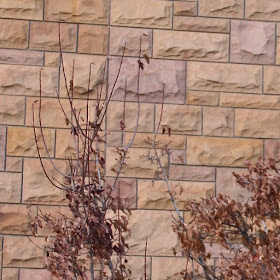I’m finishing this year’s tree-following by making plans for next year. Which tree should I follow? The Number One Candidate right now is a tree I spotted in October during my monthly visit to 2019's hawthorns. It grows near the west end of the Art Building.
It had such colorful leaves! Of course those leaves are gone now, so on my recent visit I took along the October photo. That way I would know which tree to introduce myself to.
It was cold, windy and getting dark at 4:30. I left my trusty field assistant behind after assuring her she would prefer the warmer cab of the truck.
En route to the west end of the building, I visited briefly with the pair of hawthorns I followed this year. They still had haws, but quite shriveled. I sampled one; it had the texture of fruit leather and just a hint of flavor.
With the photo I easily relocated the tree of interest. While I struggled to take a clever photo of print and tree in the wind, several people walked by and smiled. Of course they smiled—being artists, they wouldn't think that what I was doing was the least bit odd.
Assured I had the right tree, I approached it. “Hello, I’m Hollis. What’s your name?” It mimed a response, with branches, leaves and fruit. But I didn’t fully understand.
The branching was opposite (hard to see in wind, sorry):
Leaves had mostly serrated margins and pinnate veins—at least that's what I thought (mystery ahead). The second photo is a zoom from the October shot, click on it for a slightly better view:
There were many clusters of pedicels but only a few with fruit ... which happen to be keys or samaras, doubled like those of maples!
Are you surprised too? These are strange leaves for maples, especially the pinnate venation. Maybe I need to expand my concept of the Aceraceae. Learning awaits.
The other reason for choosing this tree is that it grows next to the Art Building which offers a bright warm whimsical refuge on cold, windy and/or snowy days, or when the mosquitos are bad. Currently there are several new exhibits, including one under construction. But I headed straight to the This and That Galleries because this month both have exhibits featuring plants!
I was surprised when I walked into That. Flower photos, illustrations and even scientific literature (!) hung on the walls. On a small table lay an explanation by Rebecca Austin and Erin Bentley—artist and scientist. One “needs only look at the field notebooks … to see that when people seek to understand the natural world, they often turn to artistic endeavors … we would like to show that these fields are inherently, if not always obviously, connected.”
For this beautiful illustration of Actaea rubra, they chose Alice Bacon’s 1903 paper Experiment with the Fruit of Red Baneberry “because it was funny.” So of course I had to read more. Turns out Alice performed the experiment on herself! Fortunately she survived, and duly reported her findings.
“Then suddenly the mind became confused and there was a total disability to recollect anything distinctly or arrange ideas with any coherency. On an attempt to talk, wrong names were given to objects, and although at the same time the mind knew mistakes were made in speech, the words seemed to utter themselves independently.”She experienced pain in many parts of the body. Perhaps scariest of all “the heart fluttered most unpleasantly.” After three hours she was fully recovered but “The experiment was carried no further, as the effects in heart and brain were danger signals not to be ignored.” (I didn't find the funny part.)


















If you would like a copy of Alice Bacon's 1903 paper and can't get past a firewall, email me (see Contact Tab below header). Hollis
ReplyDeleteThe October colours of the new tree are amazing. Every possible colour a leaf can have in one tree all at the same time. That part at least is maple-like.
ReplyDeleteGood point, Erika ... more evidence for maple.
DeleteNo I didn't find 'Experiment with the fruit of Red Baneberry' funny either, more like scary, glad (for her sake) she didn't take it further. The Artworks look interesting, and I would think a warm up was a good idea.
ReplyDeleteYou do like a mystery Hollis, though I will sort of be on one myself next year,and your chosen tree does look very colourful in autumn. Frances
The art building is pretty much irresistible being both interesting and warm—guess I will follow this tree, whatever it is.
DeleteAs usual I feel thoroughly enriched by your blog post, fascinating in many different ways.
ReplyDeleteI'm so glad you are continuing to follow a tree with us all next year and intrigued to know what it is.
The link didn't work for the red baneberry (no wonder they call it "bane" berry), so it would be great to see that paper. I will email you a note to ask.
Thank you for sharing your entertaining and informative travels :)
Oh yes, what a perfect tree to follow. It's beautiful! Your field assistant is a cute little buddy. Happy Holidays!
ReplyDelete